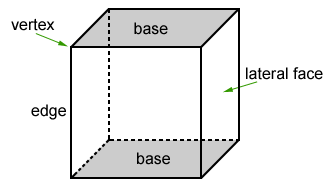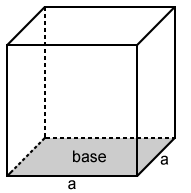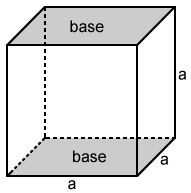Cube
A cube is a space figure with 6 square faces. It is one of the five regular polyhedra. The faces of a cube are all the same size.

Characteristics of a cube
The six identical faces of a cube are often categorized as four lateral faces and two bases. An edge of a cube is a line segment formed by the intersection of two adjacent faces. A vertex of a cube is the point of intersection of three edges.

A cube has the following characteristics:
- A cube has 6 faces, 12 edges, and 8 vertices. The 6 faces are identical squares. The 12 edges are equal in length.
- Opposite faces of a cube are in parallel planes and any two adjacent bases are in perpendicular planes.
- Any intersecting edges are perpendicular to each other.
- A cube is a regular hexahedron (all six faces are regular polygons) making it one of the five Platonic solids.
Surface area of a cube
The total surface area, S, of a cube is the area of its six identical faces:.
S = 6·a2
where a is the length of its edge and a2 is the area of one face of the square.

Volume of a cube
The volume, V, of any prism is V = l·w·h, where l = length, w = width, and h = height of the prism. Since the length, width, and height of a cube are all identical in length, the volume of a cube is:
V = a3
where a is the length of its edge.

Example:
If the volume of a cube is 125, what are the lengths of its edges?
Substituting 125 for the volume:
Therefore, the length of each edge is 5.
